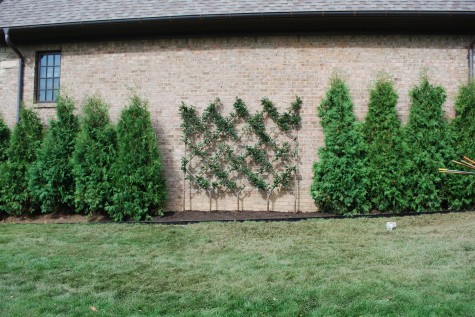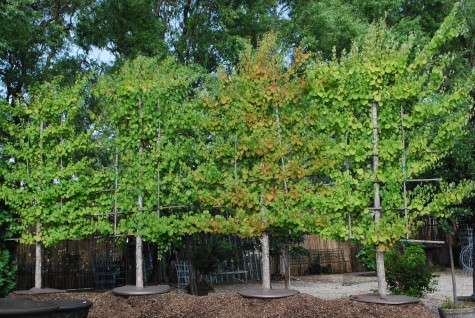 I have written about espaliered trees before. Proper pruning is an important element of good garden maintenance. But espalier-making is the intersection of the science of how things grow with the art of gardening. Interested in a little something about that history? Search the post Palmette Legendre for my short take on the practice of growing trees in two dimensions. The posts “Green Walls”, and “the 2010 espaliers” further that discussion. Given this week devoted to some thoughts about trees and the spaces they require, espaliered trees come to mind. These four old Katsura trees have been patiently trained for many years to grow wide and flat. As you can see, some of the arms have outgrown the stakes that keep them horizontal. They will continue to grow vertically, until I retie them to their training stakes. They are ready to make a flat green wall in a very narrow space.
I have written about espaliered trees before. Proper pruning is an important element of good garden maintenance. But espalier-making is the intersection of the science of how things grow with the art of gardening. Interested in a little something about that history? Search the post Palmette Legendre for my short take on the practice of growing trees in two dimensions. The posts “Green Walls”, and “the 2010 espaliers” further that discussion. Given this week devoted to some thoughts about trees and the spaces they require, espaliered trees come to mind. These four old Katsura trees have been patiently trained for many years to grow wide and flat. As you can see, some of the arms have outgrown the stakes that keep them horizontal. They will continue to grow vertically, until I retie them to their training stakes. They are ready to make a flat green wall in a very narrow space.
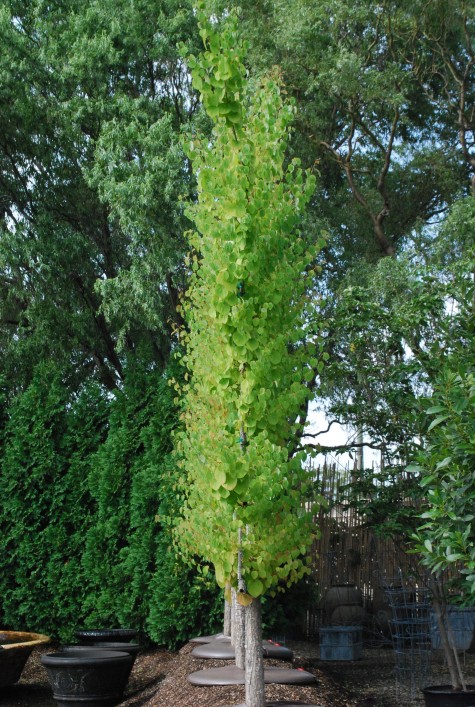 Viewed from the side, the trunks and foliage of these katsuras occupy barely 2 feet of space. The rootballs are more than twice the size of the tops. A grower in Oregon grew these incredible trees, given enormous patience, and a great love of plants. A great deal of work was needed to train these trees into this shape. Cercidiphyllum, or katsure, had a broadly oval natural shape. Changing that shape involves training from a very early age.
Viewed from the side, the trunks and foliage of these katsuras occupy barely 2 feet of space. The rootballs are more than twice the size of the tops. A grower in Oregon grew these incredible trees, given enormous patience, and a great love of plants. A great deal of work was needed to train these trees into this shape. Cercidiphyllum, or katsure, had a broadly oval natural shape. Changing that shape involves training from a very early age.
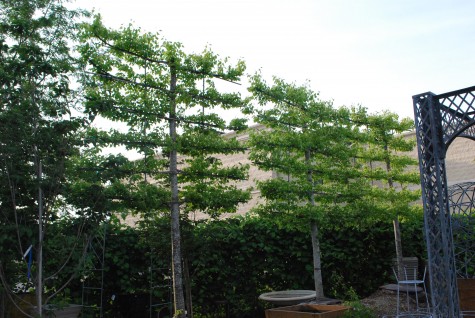 I bought old espaliered lindens from the same grower. I had to have them. I paid to dig, ball and burlap, and ship 14 espaliered trees across the country in a refrigerated truck. Nuts, yes. Think of me what you will, but these old espaliers are extraordinarily beautiful plants, and almost all of them are spoken for now. Most of the espaliers I buy are young, and of small caliper. They need a support system in order to maintain their shape. Many espaliers are grown against a wall, for this reason. These trees are old enough to be a wall. It is hard to see in this picture, but the horizontal arms are being held in place by vertical stakes. These stakes maintain a uniform distance between each arm.
I bought old espaliered lindens from the same grower. I had to have them. I paid to dig, ball and burlap, and ship 14 espaliered trees across the country in a refrigerated truck. Nuts, yes. Think of me what you will, but these old espaliers are extraordinarily beautiful plants, and almost all of them are spoken for now. Most of the espaliers I buy are young, and of small caliper. They need a support system in order to maintain their shape. Many espaliers are grown against a wall, for this reason. These trees are old enough to be a wall. It is hard to see in this picture, but the horizontal arms are being held in place by vertical stakes. These stakes maintain a uniform distance between each arm.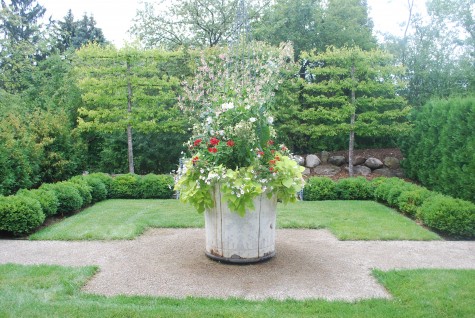 Three of the old linden espaliers got placed in a small side garden. The grade behind them rises steeply; the property line is barely 3 feet beyond the espaliers. Once the arborvitae grown, this garden will feel like a room with the sky for a ceiling. This is a garden in the process of becoming a place to be. A decision will need to be made fairly soon. If the horizontal branches are not kept pruned, the green stripes will become a green plane.
Three of the old linden espaliers got placed in a small side garden. The grade behind them rises steeply; the property line is barely 3 feet beyond the espaliers. Once the arborvitae grown, this garden will feel like a room with the sky for a ceiling. This is a garden in the process of becoming a place to be. A decision will need to be made fairly soon. If the horizontal branches are not kept pruned, the green stripes will become a green plane.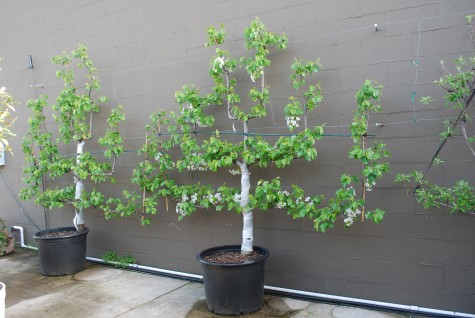 Almost any tree can be trained in two dimensions. These crabapples have been pruned in a classic candelabra form. The vertical stakes holding the arms in place are attached to wires, which are held a few inches away from the wall with bolts. This permits good air circulation on the backside of the branches.
Almost any tree can be trained in two dimensions. These crabapples have been pruned in a classic candelabra form. The vertical stakes holding the arms in place are attached to wires, which are held a few inches away from the wall with bolts. This permits good air circulation on the backside of the branches.
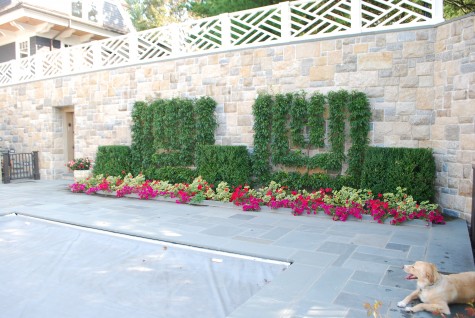 This is the third year in the ground for these crabapples. They dress up this massive stone wall without obscuring it. The total width of the bed from the wall to the bluestone terrace is 4 feet. In the absence of any green, this space would feel a little too desolate. Alternating with the espaliers-blocks of Green Mountain boxwood. They naturally grow taller than wide.
This is the third year in the ground for these crabapples. They dress up this massive stone wall without obscuring it. The total width of the bed from the wall to the bluestone terrace is 4 feet. In the absence of any green, this space would feel a little too desolate. Alternating with the espaliers-blocks of Green Mountain boxwood. They naturally grow taller than wide.
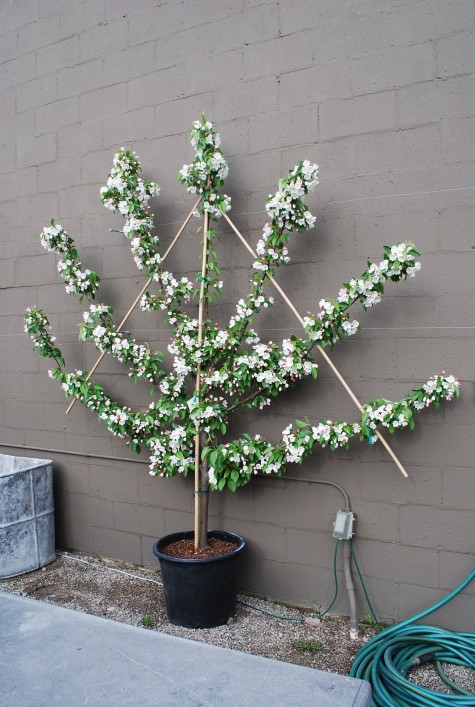 This crabapple has been trained in a fan shape. Each arm radiates out from the trunk in a symmetrical fashion. Growing an espalier in a symmetrical shape requires the selection and training of that branch which appears in exactly the right spot. I would be much better at keeping up an espalier that had been trained for a few years, than starting one from scratch.
This crabapple has been trained in a fan shape. Each arm radiates out from the trunk in a symmetrical fashion. Growing an espalier in a symmetrical shape requires the selection and training of that branch which appears in exactly the right spot. I would be much better at keeping up an espalier that had been trained for a few years, than starting one from scratch.
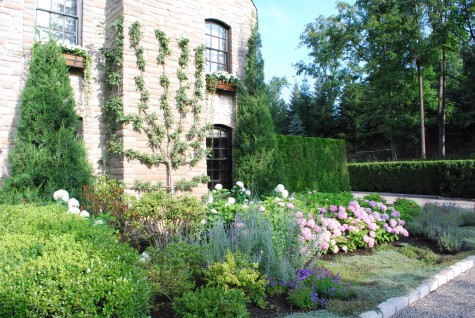 This fan espalier has been trained one step further. In addition to fanning out, it has been trained to grow over the sides of the chimney. Young tree branches are flexible, and will adapt to this training. Once the twigs attain some size, the shape often becomes self-supporting. It wil be very interesting to see the shape of this tree in 10 years.
This fan espalier has been trained one step further. In addition to fanning out, it has been trained to grow over the sides of the chimney. Young tree branches are flexible, and will adapt to this training. Once the twigs attain some size, the shape often becomes self-supporting. It wil be very interesting to see the shape of this tree in 10 years.
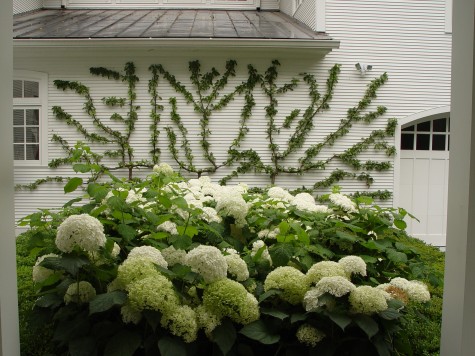
This espalier has an entirely free form shape. Taking up little more than 2 feet on the face of this wall, it is a striking addition to this garden. The combination of the narrow wood clapboard, the espalier, and the Annabelles in bloom makes quite the picture.
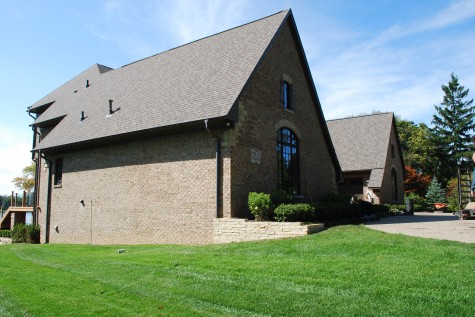 Driving up the street to this property for the first time, I was struck by how this giant bare wall seemed to be asking for something. As maintaining access to the lake was a very important issue, an espalier of some kind seemd like a good idea.
Driving up the street to this property for the first time, I was struck by how this giant bare wall seemed to be asking for something. As maintaining access to the lake was a very important issue, an espalier of some kind seemd like a good idea.
These 5 trees are trained in an espalier pattern known as a Belgian fence. When these apple trees were a single whip, 4 feet tall, they were pruned down to within a foot of the ground. When a pair of branches emerged at that cut, they were potted, and staked to create the beginning of a lattice fence. Given another 10 years, they will cover this section of wall, and provide plenty of apples. Were I a young gardener, I would make it my business to espalier something-for the fun of it now, and the beauty of it later.
